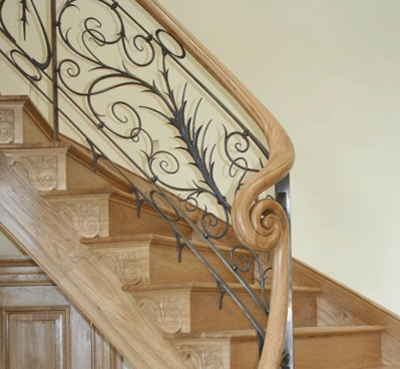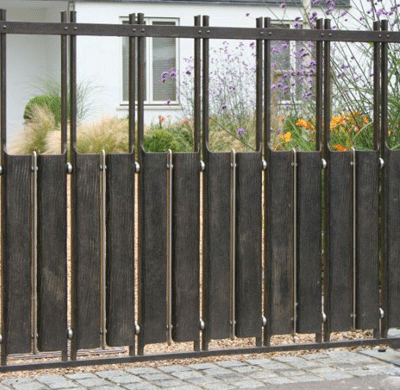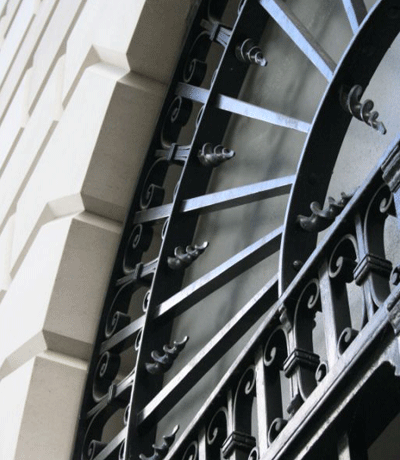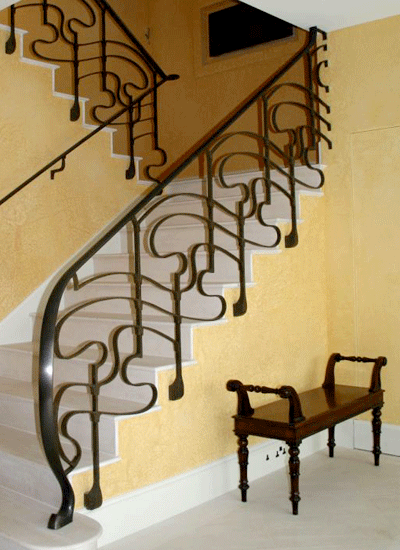Commissioning bespoke ironwork
Most ironwork is commissioned because it has to work in a particular space and it’s also an opportunity to introduce some artwork into your house

There is little choice in architectural ironwork available ‘off the shelf' ready to install; in fact most is commissioned. This is because, like a kitchen, each piece of ironwork is installed to a different size and layout, but also just like a kitchen you can either buy a personalised assembly of mass produced catalogue components or have a traditionally crafted piece made from scratch. Decisions on which one are often based on cost alone but in light of the saying ‘you get what you pay for', it is worth remembering that there are other details to consider in making your choice!
Before getting caught up in the details of any project there are three things to consider and understand to help you decide if handmade forged ironwork is for you.
Adding that ‘extra' something
Ironwork is an ideal medium for visual expression and commissioning a blacksmith to create a unique piece of forged ironwork is an inspired way to enhance the spaces around you where you live and work. Sculptural items may spring to mind when thinking of that ‘extra' something but it is important to remember that ironwork also provides an opportunity for design ideas to be incorporated into everyday functional items. The combining of function and art in must-have items like gates, railings and balustrades can be a convenient, economical and depending on how adventurous you are a ‘fun' way to improve both private and public spaces.

This is by no means a new idea as the heyday of architectural ironwork was during the building booms of the nineteenth century, when ironwork was regarded as an indispensible part of the design of pretty well any building development. The metalwork was often seen not so much as answering a practical need, but instead as a part of the overall artistic design concept of the building. As such the appearance of classically inspired buildings can often be denuded by the removal of the ironwork, and equally, new buildings can often be enhanced by its inclusion.
Craftsmanship
Quality of workmanship is of course the prime reason why people commission a traditionally crafted piece and as such it is important to appreciate and understand the particular craft you're working with, in this case ‘forging'. The first thing to remember is that decorative ‘forged' ironwork is the work of the ‘Blacksmith' a distinct and skilled craftsman (not a skill to be confused with the work of the ‘Farrier' who shoes horses). However, be careful as any metalworker can call themselves a ‘Blacksmith' as the term is not protected by law in the same way that, for example, ‘Architect' is. It is therefore essential that you select your craftsman carefully by thoroughly studying their portfolio and viewing a sample of their work.
Exquisite houses, the beauty of Nature, and how to get the most from your life, straight to your inbox.
The difficulty here is that quality workmanship is subjective as it can be achieved by a wide variety of metalworking techniques and processes both new and old including Casting, Fabrication and Blacksmithing. There is no one that is right for all purposes and in fact, as each has its own merits, there are many situations where a combination of techniques are used. You need to establish for yourself what type of ‘craftsmanship' you are after as each workshop you approach will have their own preferences and undoubtedly try to convince you to there way of thinking. The point to remember is that the final product of each method of work is very different and as such there are applications when the forged work of the blacksmith has superiority.
To understand this idea, keep in mind that forging is a process of working and shaping the ironwork when it is hot. The quality of workmanship it offers is through the forging process which invests the finished work with a special interest and character.
The qualities of the blacksmith's craft can be identified in the visual detailing of their work where, for example, a change of section through a taper from thick to thin may be used for visual and physical strength where required. Texture can also be achieved naturally through the forging process, resulting in more interesting surface qualities. This sort of detailing and the adaptability of the material offers greater three dimensional possibilities and can resolve difficult design areas in an aesthetically pleasing way.
This malleability of the hot iron in turn is used to detail the jointing construction of the finished piece. This provides an often simple yet powerful sense of structure and an eloquence of detailing in a way that the mechanical cut cannot achieve.
Don't forget however that this is a ‘skilled' craft and so just because its forged you shouldn't forget that from the craftsman we expect a high degree of accuracy, but not necessarily one reliant on the micrometer but rather on the hand and eye. Attention to detail should of course be prevalent throughout with curves that flow, joints that fit and a careful consideration of the construction to make sure it is suited to a lifetime of service.

Design
Commissioning architectural ironwork is usually a one off investment in a permanent feature, and it is essential that you invest properly in the design process.

Forged ironwork is an ideal medium for designing with as its unique versatility allows for an inventive and creative approach to each project. Not being limited to available components, or what a machine can or can't do, you have the ability to get a design that is personalised to your specific requirements. Because of this blacksmithing is a thriving craft. This is not to say that every design should be a stand alone work of art but that, even if you want simple period style railings, to be impressive the design should be of a high standard of aesthetic quality and should include integrity of detailing to ensure craftsmanship is evident in the finished piece.
Specialised knowledge of metal craft, and experience in three-dimensional realisation of design ideas is indispensible to a successful design. Although there are many people who will be prepared to ‘design' for you without specialist knowledge you may not be getting value for money or the best from your project. A specialist will be able to guide the design in relation to your budget, so there are no nasty surprises, and make sure you are aware of the full range of options and possibilities or even correct period style. Last but not least they will provide a design that is suitable and practical for construction, preventing future problems and ensuring that you're commissioning the work you actually desire.
The majority of ‘true' blacksmiths design and make all their work, and frequently trade using the term ‘artist blacksmith'. This gives you choice in selecting an appropriate specialist to work with but as independent artists few sell their designs for others to make. Artists copyright their designs so you will need to decide at the outset if you are going to select an artist to commission for both the design and build or if you want to commission a design on which you can then go to tender for comparative quotes.
You may be thinking ‘but I already have a design idea', in which case you can approach an ironwork designer to provide the specialist technical information you need to turn your ‘concept' into a fully developed practical design. Before this stage is done you will be unable to get directly comparable quotations from contractors because each contactor will have to ‘interpret' in their own way the detailing and construction. If you choose to go to tender on your concept then you need to remember that there is a wide disparity in cost between the cheapest work and the finest, but without a fully developed design work acquired on a competitive basis will tend towards the lower order.

As with any discipline the best designs require specialist knowledge but they are not expensive and will have major benefits.
The Ironwork Studio works with clients who wish to acquire fine ironwork and directly comparable quotations from contractors. Our work ranges from heritage to new build and we particularly enjoy inspiring our clients with the design and creative possibilities of forged ironwork. Perhaps we could do the same for you.

The Ironwork Studio is a member of ProjectBook which has been created to help owners of listed or period properties understand how their buildings work and to help them find appropriate craftsmen, products and specialist information. The online Heritage Register contains over 540 registered businesses, the largest directory of its type in the UK. For more information, visit www.projectbook.co.uk.
Country Life is unlike any other magazine: the only glossy weekly on the newsstand and the only magazine that has been guest-edited by His Majesty The King not once, but twice. It is a celebration of modern rural life and all its diverse joys and pleasures — that was first published in Queen Victoria's Diamond Jubilee year. Our eclectic mixture of witty and informative content — from the most up-to-date property news and commentary and a coveted glimpse inside some of the UK's best houses and gardens, to gardening, the arts and interior design, written by experts in their field — still cannot be found in print or online, anywhere else.
